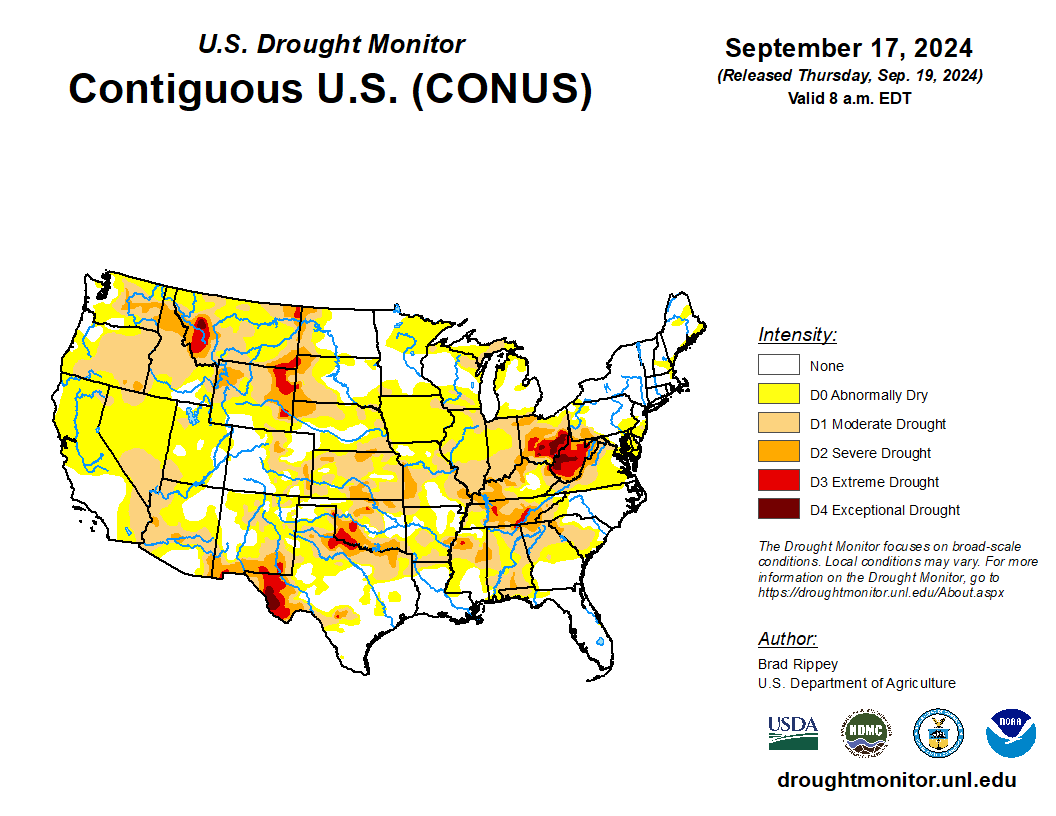U.S. Weather/Crop Progress


Highlights:
- 9% of the corn is now harvested, up 4 points from last week, 1 point ahead of last year and 3 points ahead of the 5-yr average. Sorghum harvest is at 24%, 1 point ahead of last year and even with the 5-year average. Barley harvest is now 94% completed, up 5 points from last week, 2 points ahead of last year and 1 point ahead of the 5-year average. Soybean harvest in now underway and 6% completed, 2 points ahead of last year and 3 points ahead of the 5-year average.
- The corn crop condition rose 1 point this week with the Good/Excellent rating at 65%. Hot dry weather is pushing corn to dry down as harvest approaches. Sorghum condition dropped 4 points with the G/E category at 44%. 23% of sorghum is now rated poor to very poor condition due to excessive heat and dryness. The soybean condition rating dropped 1 point to 64% G/E.
- In the West, mostly dry weather favors fieldwork. Early today, any precipitation is confined to parts of central California. In Arizona, the cotton harvest was 17% complete by September 15, ahead of the 5-year average of 9%. On the same date, the California rice harvest was 15% complete, ahead of the average of 7%. Elsewhere, Northwestern winter wheat planting ranged from 11% complete in Idaho to 43% in Washington.
- On the Plains, late-season heat prevails across the southeastern half of the region, where today’s high temperatures should range from 90 to 100°F. In contrast, recent rainfall in Montana has provided locally significant drought relief, with scattered thunderstorms extending to other areas of the northern Plains and High Plains. Still, many areas of the Plains would benefit from additional rain, especially as the winter wheat planting and establishment season proceeds.
- In the Corn Belt, showers stretch southward from Minnesota. The rain is causing only minor fieldwork delays and having little impact on pervasive Midwestern dryness. Warmth prevails throughout the Midwest, with Thursday’s high temperatures expected to range from 80 to 90°F—with higher readings possible in the southwestern Corn Belt.
- In the South, a few showers linger along and near the Atlantic Coast. Warm, dry weather covers the remainder of the South. Following recent rainfall from Hurricane Francine and Potential Tropical Cyclone Eight, the South is an odd mix of wet and dry conditions, sometimes across small geographic areas. Even in areas where recent rainfall has been substantial, lingering Southern agricultural drought impacts include poor pasture conditions and low pond levels.
Outlook:
Favorably active weather across the nation’s mid-section should peak in intensity during the weekend, with significant precipitation (generally 1 to 3 inches) expected from central sections of the Rockies and Plains into the Midwest. Although the precipitation will slow fieldwork, including harvest activities, benefits should include a potential boost in river levels and improving topsoil moisture for pastures and winter grains. However, many areas of the country, including the South and much of the West, will experience dry weather during the next 5 days. Unusual warmth will accompany the Southern dryness; during the weekend, above-normal temperatures will also return across California and the Desert Southwest. In the Atlantic Basin, there is the potential for tropical cyclone development by early next week over the western Caribbean Sea, with implications for the U.S. if the future system enters the Gulf of Mexico. The NWS 6- to 10-day outlook for September 24 – 28 calls for near- or above-normal temperatures nationwide, with the West, North, and southern Texas having the greatest likelihood of experiencing warmer-than-normal weather. Meanwhile, near- or below-normal precipitation across the western and north-central U.S., as well as northern New England, should contrast with wetter-than-normal conditions from the central and southern Plains to the Atlantic Coast, extending as far north as the Ohio Valley and southern New England.

